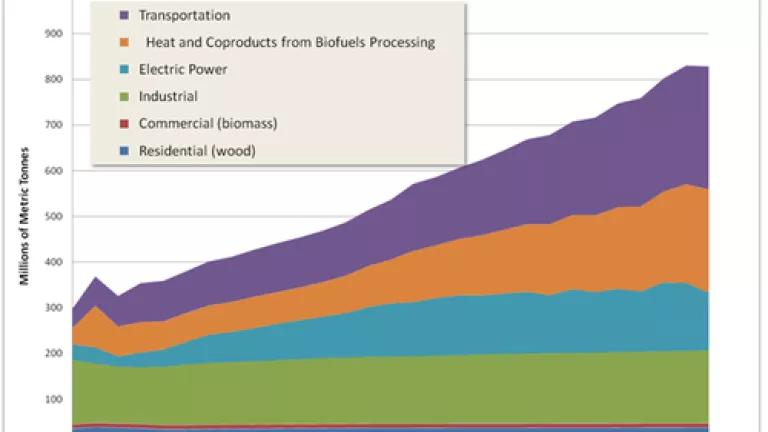
Yesterday I wrote about 90 leading scientists calling on Congress and the Obama administration to carefully account for the greenhouse gas emissions from burning biomass. I want to underscore again that now is the time for Congress to pass a climate bill, and the House ACES bill and Kerry-Lieberman APA provide a solid framework. (You can link here, here and here for more information on the bill's various provisions,)
Today I'm digging into some DOE data that gives a measure of how important it is to get the biomass accounting right and casts some light on how final legislation can ensure the treatment of biomass supports the carbon reduction goals.
It's easier to understand why the biomass loophole is wrong if we think about an extreme example: both versions of climate legislation would give a utility a free pass if it replaced coal with wood — even if that wood came from a forest that was clear-cut and turned into a parking lot. In other words, even when carbon that was locked up in soils and wood is released with no chance of reabsorption, the accounting in ACES and APA would count it as zero emissions.
Here's how DOE's Energy Information Administration explains its own accounting, which mirrors the proposed climate legislation:
CO2 emissions from the combustion of biomass to produce energy are excluded from the energy-related CO2 emissions reported in AEO2010. According to current international convention, carbon released through biomass combustion is excluded from reported energy-related emissions. The release of carbon from biomass combustion is assumed to be balanced by the uptake of carbon when the feedstock is grown, resulting in zero net emissions over some period of time. However, analysts have debated whether increased use of biomass energy may result in a decline in terrestrial carbon stocks, leading to a net positive release of carbon rather than the zero net release assumed by its exclusion from reported energy-related emissions.
That's how we end up with the biomass loophole: we exclude biomass combustion emissions from energy-related accounting and fail to regulate terrestrial carbon. Both ACES and APA fall into this trap.
As I mentioned yesterday, EIA does forecast the smokestack and tailpipe greenhouse gas emissions from biomass power, heat and fuels. The figure below shows the reference-case biogenic emissions through 2035.
[Note: Heat and coproducts from biofuels processing is listed under industrial emissions as "biofuels heat and coproducts." But after talking to the helpful folks at EIA, I understand this to account for the balance of carbon that goes into biofuel refineries in the form of feedstock and doesn't come out as biofuels. Makes sense. It's got to go somewhere.]
Now some will look at this and point out that the majority of these emissions are associated with biofuels--either the burning of biofuels in cars and trucks or the producing of biofuels at refineries--and these emissions are covered by the Renewable Fuel Standard as updated in EISA2007. But as I explained yesterday, the efforts to prop the biomass loophole open go hand in golve with efforts to gut the protections in the RFSII. Both ACES and APA would expand the definition of renewable biomass to include just about anything, and ACES included a provision prohibiting EPA from accounting for the single largest source of GHG pollution associated with most conventional biofuels—the market ripple effect caused by increased biofuels use, also known as international indirect land-use change.
And as if the incentive for bad biofuels created by a climate bill with a loophole that also guts the environmental protections in our existing biofuels policies wasn't bad enough, the corn ethanol industry is doing a full court press to try to extend its tax credit, which by all rights should expire this year. I've written before about how this $0.45 per gallon give-away lines to pockets of big oil and old ethanol and is the most expensive way to create jobs and ravish the environment.
EIA provides a scenario, called the "no sunset" scenario, which gives a bit more insight into the climate cost of the VEETC. As the name suggests, this scenario assumes that the VEETC and other biofuels tax credits don't expire. The result is nearly 20% more CO2 emissions from the burning of biomass and this doesn't even factor in the incentive created by a climate bill with a loophole. Here's what the emissions chart looks like in this case:

The good news from these graphs is that they suggest a path forward for Congress. The most important step is to protect the definition of renewable biomass and the full GHG accounting established under the RFSII through EISA2007.
Then through the climate bill, Congress should put our GHG controls on track to fully and carefully account for the pollution emissions and sinks associated with different sources of bioenergy. Specifically, we recommend that Congress direct EPA to work with USDA and DOE to commission a study by the National Academy of Sciences to evaluate and measure emissions associated with bioenergy and how to account for them. EPA should establish rules to cover these emissions under a cap based on the recommendations of the study.
Finally, Congress should let the VEETC expire at the end of this year. It's time to stop throwing good tax payer dollars after bad biofuels. We can do better--more jobs, less pollution, more energy security--investing in better biofuels, wind power, solar power... just about anything.
